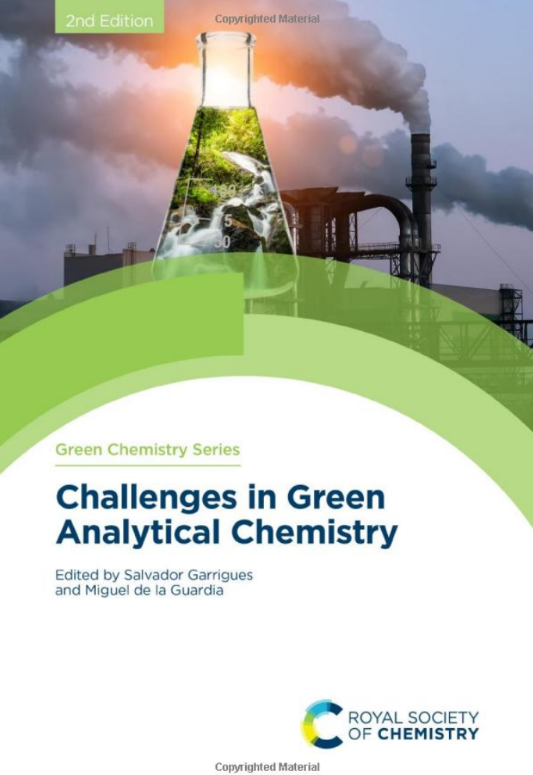Challenges in Green Analytical Chemistry
Green analytical chemistry is the concept of making analytical chemistry safer for operators, more sustainable for the environment, and more economical.
|
Green analytical chemistry can involve choice of technique (including miniaturisation), sample pre-treatment, choice of solvents and reagents, or computer optimisation of procedure. Portable or handheld equipment may be available which would avoid the need for laboratory analyses. In this book, each chapter is written by a different author in the form of a detailed literature review. Examples are chosen from the whole area of chemical analysis with many details for environmental samples.
After an introductory chapter, the book continues with spectroscopic methods needing no sample pre-treatment, both invasive and non-invasive techniques, and also image analysis. The chapter covers the whole of the electromagnetic spectrum, mass spectrometry, and NMR, and so is sometimes difficult to follow, but provides a useful overview. It brings together many techniques overlooked in conventional chemical laboratories and includes a section on remote sensing. The following chapter describes developments in biosensors, often in the form of simple, easily transportable meters. These have much application for personal monitoring in the biomedical field, but have currently more limited application for environmental samples as they are often for single analytes. Some developments are for less specific analytes, one cited being toxicity testing for wastewater treatment plants. Developments will expand the use of simple affordable techniques; e.g. colorimetric sensors using mobile phones and technology used in portable glycometers. |
The major consideration of solvent choice is covered in several chapters, including not only conventional organic solvents but also alternative approaches such as solvent free microwave extraction, supercritical fluids, ionic liquids, or near critical water extraction. A large section is devoted to miniaturised extraction techniques, including single drop microextraction and stir bar sorptive extraction. It concludes that many of the novel techniques have so far found limited widespread acceptance.
Two chapters are devoted to the specific areas of (bio) electroanalysis and flow analysis, introducing the techniques as tools for green analytical chemistry and describing current green developments; for instance, alternatives to mercury electrodes and replacement of hazardous chemicals.
Liquid and gas chromatography are discussed in a single chapter. Variations in technique such as two-dimensional chromatography, portable systems, online and at-line process chromatographs, and miniaturisation are included. Nevertheless, this chapter feels severely limited. Many of the techniques as used in cutting edge analysis would couple the chromatography to mass spectroscopic detectors with necessary chemometric processing of the vast amount of data produced. There is no discussion of this and, for instance, that recent advances in instrumentation reduce or remove the need for chemical pretreatment. A separate chapter on mass spectroscopic analysis would have been a very useful addition.
Chemometrics helps researchers in data manipulation, analysis, and automated information extraction. The chapter on this topic is a useful detailed summary of the methods used. Examples include analysis of PAHs and antibiotics in sediments, but the use of chemometrics in minimising environmental impact of analysis is not well highlighted, one of the most effective methods being in method design to reduce the number of samples needed.
The final chapter appraises the “greenness” of analytical methods, giving one example of DDT analysis in honey. It is only here that other vital aspects of any analytical procedure such as speed of analysis and limit of detection are considered. With such a general term, “greenness”, it is not surprising that results differ according to the criteria set.
This book is a good library of new methods for analysis and recommended for analytical chemists. However, in such a fast developing area, a final case study chapter on how green modifications are being applied in industry and existing long term monitory schemes would be welcome.
Two chapters are devoted to the specific areas of (bio) electroanalysis and flow analysis, introducing the techniques as tools for green analytical chemistry and describing current green developments; for instance, alternatives to mercury electrodes and replacement of hazardous chemicals.
Liquid and gas chromatography are discussed in a single chapter. Variations in technique such as two-dimensional chromatography, portable systems, online and at-line process chromatographs, and miniaturisation are included. Nevertheless, this chapter feels severely limited. Many of the techniques as used in cutting edge analysis would couple the chromatography to mass spectroscopic detectors with necessary chemometric processing of the vast amount of data produced. There is no discussion of this and, for instance, that recent advances in instrumentation reduce or remove the need for chemical pretreatment. A separate chapter on mass spectroscopic analysis would have been a very useful addition.
Chemometrics helps researchers in data manipulation, analysis, and automated information extraction. The chapter on this topic is a useful detailed summary of the methods used. Examples include analysis of PAHs and antibiotics in sediments, but the use of chemometrics in minimising environmental impact of analysis is not well highlighted, one of the most effective methods being in method design to reduce the number of samples needed.
The final chapter appraises the “greenness” of analytical methods, giving one example of DDT analysis in honey. It is only here that other vital aspects of any analytical procedure such as speed of analysis and limit of detection are considered. With such a general term, “greenness”, it is not surprising that results differ according to the criteria set.
This book is a good library of new methods for analysis and recommended for analytical chemists. However, in such a fast developing area, a final case study chapter on how green modifications are being applied in industry and existing long term monitory schemes would be welcome.
Reference
Challenges in Green Analytical Chemistry, ed. S. Garrigues and M. de la Guardia, Royal Society of Chemistry, Cambridge, 2nd Edition, 2020. ISBN 978-1-78801-537-0
Challenges in Green Analytical Chemistry, ed. S. Garrigues and M. de la Guardia, Royal Society of Chemistry, Cambridge, 2nd Edition, 2020. ISBN 978-1-78801-537-0


